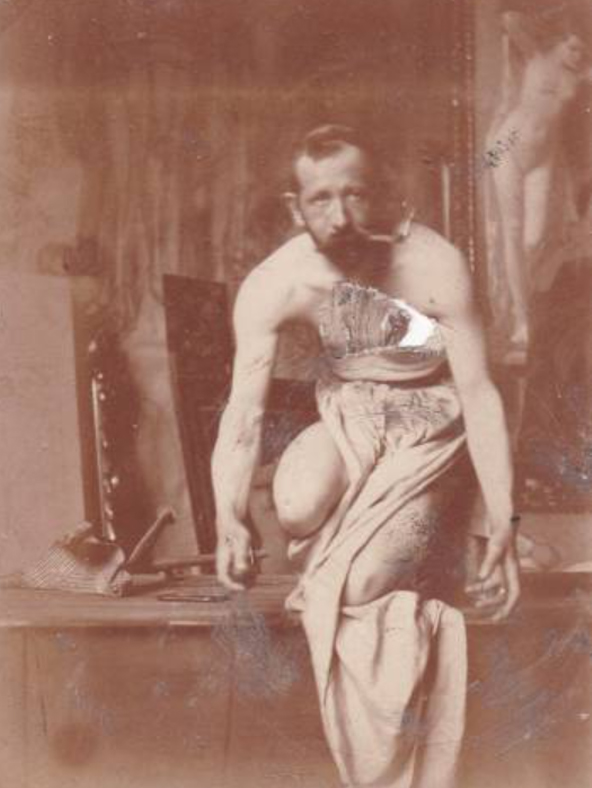Stein János Gábor

1874, Cluj - 1944, Budapest
The Life
Because of his withdrawn nature, the artist lived a modest life. He spent his days in the silence of his huge workshop, arranged in a villa in Budafok, where he worked persistently on creating a legacy of remarkable quality.
The Art
Stein Janos Gabor was a painter and a graphic artist. In addition to the easel and monumental painting, he designed mosaics and stained glass. Stein was a follower of the conservative, academic pictorial tradition, and his paintings show a high level of technical knowledge, through a precise composition, fine brushing, and an intimate, sensual pictorial way. His style was strongly influenced by the art of his master Karoly Lotz.
First-generation success
The Stein family name carries with it certain importance in the business scene of 1870's Cluj.
Janos Stein senior established it himself, after studying business in Bratislava and moving to Transylvania, where he got a job at Gabor Barra's bookstore in Cluj. It didn't last long until he took over the business and transformed it into a success. In the 1870s, Stein became the main book supplier for the most important institutions in Cluj - the Transylvania Museum Society and Franz Iosif University. In addition to running the bookstore, he managed a loan library, which was later labeled as a "spiritual inn" by the famous literary historian Pal Gyulai, because many of the city's intellectuals gathered there.
Art as a clear path to success
It was in this highbrow environment that young Janos Stein developed an interest in arts and turned to a career as a painter. His father's "spiritual inn" was the perfect place where one could absorb all the specific stages of artistic formation. After graduating from high school in Cluj, Janos junior pursued his artistic studies at the Academy of Arts in Berlin and then Munich, where he studied under teachers like Gabriel von Hackl (shapes drawing), Friedrich Woldemar (decorative art), and Wilhelm von Diez (painting). The desire of becoming a great artist and deepening his knowledge led him to continue studying at the Julian Academy in Paris, under the guidance of professors Benjamin Constant and Jean-Paul Laurens. He kept a focus on achieving greatness and considered it was of great importance to go on study trips. Between 1900 and 1905 he traveled to England, Netherlands, and Belgium to learn more about different art styles. He returned to Budapest where he finished his art studies at the Higher School of Fine Arts, under the mentorship of Karoly Lotz.
Achieving second-generation greatness
He frequently participated in exhibitions in Műcsarnok Budapest, where he won numerous awards. But he didn't stop here. Together with his mentor Karoly Lotz, Janos undertook monumental decorative projects in Budapest, such as frescoes. Some of the monumental frescoes he painted can be found in the Mor church (on the domes of crypts, in the two rows of monumental arches overlooking the cemetery on Fiumei Street), in the restaurant of the Hungarian Parliament, the cathedral in Eger, and the parish church of Nyíregyháza. In 1905 he designed and executed for free the frescoes in the sanctuary at the Roman Catholic church of Saint Peter in Cluj. That same year he published a personal volume entitled Artistic Anatomy (Művészeti bonctan). It was the first book published in Hungarian on that subject.
From 1920 he appeared in the archives of the Hungarian National School of Applied Arts as being a teacher. Stein's career ended tragically in 1944 when he took his own life.
In 2017, the artist's entire legacy was discovered almost intact in Budapest, comprising over 150 paintings, sketches, notes, and documents. From this material, the Kieselbach Gallery in Budapest organized an exhibition to shed light on the work of this forgotten artist. In Stein's works, the nude is predominant, being placed either in a mythological context (like Perseus and Andromeda), or a display of anatomical details (Semiprofile of an old woman). In the preface of his books, Stein wrote a confession about the human body: “The human figure is the one with which we can best express our pains, joys, struggles, worries, feelings of good and evil and so on. So in a word, the myriad variations of the hectic life.



